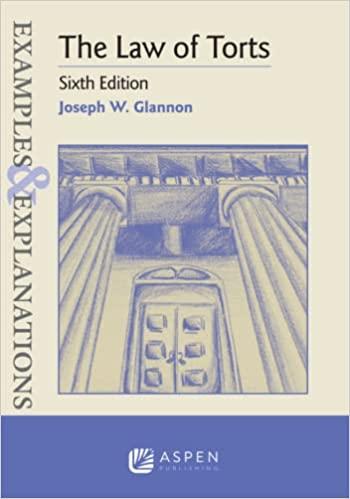Question
Which of the following is true of Chapter 11 of the BankruptcyCode? A. The filing of a Chapter 11 petition immediately enables creditors to recover
Which of the following is true of Chapter 11 of the BankruptcyCode?
A.
The filing of a Chapter 11 petition immediately enables creditors to recover thedebtor's property.
B.
Chapter 11 helps the debtor reorganize with a new capital structure so that the debtor emerges from bankruptcy as a viable concern.
C.
Chapter 11 does not permit a debtor to reject executory contracts or unexpired leases.
D.
Chapter 11 is a rehabilitation form of bankruptcy that permits bankruptcy courts to supervise thedebtor's plan for the payment of unpaid debts.
The general duty standard of the Occupational Safety and Health Act requires an employer to provide a work environment that does not result in itsemployees' mental stress.
A.
True
B.
False
Limited partners are liable for company obligations only up to the amount of their capital contribution.
A.
False
B.
True
Which of the following is FALSE about wrongful discharge for termemployment?
A.
An employer who terminates a term employee without cause is liable for wrongful discharge.
B.
An employer who terminates a term employee without cause will owe damages to the employee.
C.
A term employee can be terminated for cause without being liable for damages.
D. Most employees are term employees.
Nathan opens a clothing store called"The ClothingStore" and operates it as a sole proprietorship. Nathan files the proper statement and publishes the necessary notice of the use of the trade name. Nathan contributes$25,000 of his personal funds to the business and borrows$100,000 from a bank in the name of the business. After severalmonths, Nathan closes the business because it is unsuccessful. At the time it isclosed, the business has noassets, owes the bank$100,000, and owes other debts of$25,000. Which of the following is a correct statement regardingNathan's personal risk exposure for his unsuccessfulbusiness?
A.
Nathan is entitled to recover his$25,000 capitalcontribution, and he is not responsible for the$100,000 debt owed to the bank and the$25,000 owed toothers, since those debts were undertaken for the benefit of the business.
B.
Nathan loses his$25,000 capitalcontribution, and he is responsible for the$100,000 debt owed to thebank, but not the$25,000 debt owed to others.
C.
Nathan loses his$25,000 capitalcontribution, and he is responsible for the$100,000 debt owed to the bank and the$25,000 debt owed to others.
D.
Nathan loses his$25,000 capitalcontribution, and he is responsible for the$25,000 debt owed toothers, but not the$100,000 debt owed to the bank since that debt was undertaken for the benefit of the business.
E.
Nathan loses his$25,000 capitalcontribution, but he is not responsible for the$100,000 debt owed to the bank and the$25,000 owed toothers, since those debts were undertaken for the benefit of the business.
Which of the following is true of Chapter 13discharge?
A.
All unpaid taxes are discharged under Chapter 13 discharge.
B.
It is not granted if the debtor has received Chapter 7 discharge in the last four years.
C.
It is granted only for the secured unpaid debts of a debtor.
D.
It is granted before a Chapter 13 plan of payment is enforced.
Step by Step Solution
There are 3 Steps involved in it
Step: 1

Get Instant Access to Expert-Tailored Solutions
See step-by-step solutions with expert insights and AI powered tools for academic success
Step: 2

Step: 3

Ace Your Homework with AI
Get the answers you need in no time with our AI-driven, step-by-step assistance
Get Started


